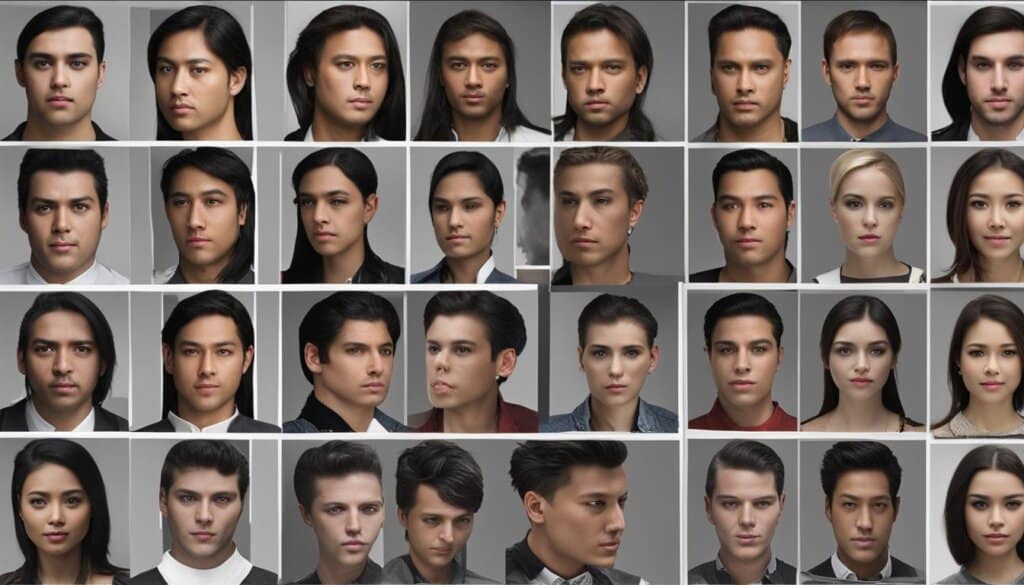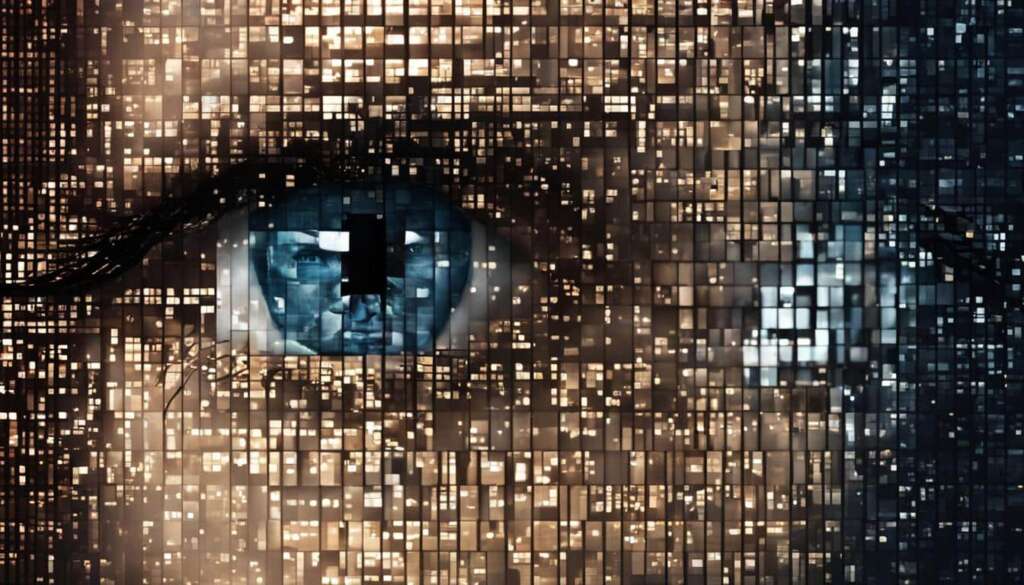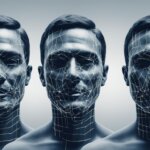Table of Contents
Welcome to our article on deepfake technology, a fascinating and controversial advancement in the realm of synthetic media. In today’s digital age, where information is pervasive and easily manipulated, the concepts of media authenticity, truth, and trust online have become increasingly important. Deepfakes, with their ability to alter images and videos convincingly, have sparked concerns and raised questions about the veracity of online content.
So, what exactly is deepfake technology? Deepfakes involve the use of advanced techniques, such as facial recognition algorithms and deep learning networks, to swap a person’s likeness in an image or video with another person’s appearance seamlessly. Originally, deepfakes were associated with the creation of explicit content using face-swapping technology. However, the scope of deepfakes has expanded to encompass a wider range of applications, including the generation of artificial images and videos of individuals who do not even exist.
The creation of deepfakes relies on a combination of techniques, including facial recognition algorithms, generative adversarial networks (GANs), and variational auto-encoders (VAEs). To craft a deepfake video, a creator needs two auto-encoders trained on different sets of faces. One encoder is trained on the targeted person’s face, while the other is trained on a diverse range of faces. Training data, which involves capturing various poses and lighting conditions, plays a crucial role in achieving convincing results.
As deepfake technology continues to advance, detecting and defending against manipulated media has become a challenge. However, there are signs to watch out for, such as unusual facial or body movements, unnatural coloring, and inconsistencies in audio. Critical thinking skills and questioning the source, timing, and motivation behind a video or image can help verify its authenticity. Applying methods to verify online information, such as investigating the provenance, source, date, location, and motivation, is vital in navigating the digital landscape.
While the battle between deepfake creators and detectors is ongoing, it is essential for individuals to be aware of the existence of deepfakes and their potential repercussions. By understanding the technology and its implications, we can better safeguard media authenticity, truth, and the trust we place in digital content.
What is a Deepfake?
A deepfake is a type of synthetic media that involves swapping the likeness of a person in an image or video with someone else’s. The term “deepfake” was coined in 2017 and initially referred to explicit content created using face-swapping technology. However, it has now expanded to include a broader range of applications, including the creation of artificial images and videos of people who don’t exist. Deepfakes are a product of advancements in technologies such as facial recognition algorithms and deep learning networks.
Deepfake technology has raised concerns about media authenticity and the potential for manipulation, posing significant challenges regarding truth and trust online. While deepfakes can be used for negative purposes, such as spreading misinformation or generating explicit content, they can also have positive applications. In the world of marketing and advertising, for example, deepfakes offer innovative ways to engage audiences and create captivating brand experiences.
“Deepfakes have revolutionized the way we perceive and interact with media. They have blurred the line between reality and fiction, raising important societal and ethical questions. As synthetic media becomes increasingly sophisticated, it is crucial that we develop strategies and tools to detect and mitigate the potential risks they pose.”
Deepfakes demonstrate the power of synthetic media and its ability to mimic real individuals convincingly. The rapid evolution of this technology has led to an array of applications, both positive and negative, that challenge our understanding of truth and authenticity in the digital age.
The Origin of Deepfakes
The origin of deepfakes can be traced back to the development and advancement of deep learning algorithms. Deep learning refers to a subset of machine learning techniques that employ artificial neural networks to simulate human-like decision-making processes. The breakthroughs in deep learning, particularly in the field of computer vision, have paved the way for the creation of realistic deepfakes.
The concept of deepfakes became popularized in 2017, when a Reddit user named “Deepfakes” introduced a platform for creating and sharing manipulated videos. At the time, deepfakes primarily involved swapping the faces of celebrities onto adult film stars in explicit content. However, the technology quickly evolved beyond its original boundaries and expanded into various other areas, presenting both challenges and opportunities.
Synthetic Media Applications
The applications of synthetic media, including deepfakes, extend far beyond the realm of explicit content. Today, deepfakes find utility in areas such as entertainment, art, education, and even politics. They can be used to create hyperrealistic renderings of historical figures, generate digital avatars for virtual assistants, replace actors and actresses in films, and simulate realistic training scenarios.
As synthetic media continues to evolve, it is essential to explore both the positive and negative implications it holds for society. While deepfakes can undoubtedly be misused for malicious purposes, they also offer incredible potential in various creative and practical domains. Understanding the origins and applications of deepfakes will help navigate the complexities of this technology and foster a future where synthetic media contributes positively to various industries.
How are Deepfakes Created?
Deepfakes are a product of various techniques, combining facial recognition algorithms, generative adversarial networks (GANs), and variational auto-encoders (VAEs). These sophisticated tools allow creators to manipulate digital content and swap the likeness of individuals in images and videos.
Creating a deepfake video involves training two auto-encoders on separate sets of faces. One auto-encoder is trained on the face of the targeted individual, while the other is trained on a diverse range of faces. This training data is essential for the deepfake creation process, as it captures various poses and lighting conditions that contribute to the realistic appearance of the final deepfake.
The generative adversarial network (GAN) and variational auto-encoder (VAE) play pivotal roles in the deepfake creation process. The encoder component of the VAE extracts facial features from the targeted person’s face, while the decoder component combines these features with the body movements and expressions from the source video. The result is a convincing deepfake that seamlessly swaps the targeted person’s face onto someone else’s body.
Deepfake creation relies heavily on computational power, as the algorithms need significant resources to process and manipulate large amounts of data. The training process involves iteratively refining the deepfake model to improve the accuracy and visual fidelity of the generated content.
However, the ethics and potential misuse of deepfake technology raise concerns. It can be used for malicious purposes, such as spreading misinformation, blackmail, and defamation. The ease of deepfake creation combined with the potential harm it can cause highlights the need for robust detection and defense mechanisms.
By understanding how deepfakes are created, individuals can better recognize their potential presence and take steps to verify the authenticity of visual content they encounter online.

Key Points:
- Deepfakes are created using facial recognition algorithms, generative adversarial networks, and variational auto-encoders.
- Training data, which includes various poses and lighting conditions, is crucial for realistic deepfake generation.
- The encoder and decoder components of the variational auto-encoder are used to swap faces onto different bodies.
- Deepfake creation requires significant computational resources and iterative refinement.
- Understanding the process helps individuals recognize and verify deepfakes.
Detecting and Defending Against Deepfakes
Detecting deepfakes can be challenging, but there are some signs to look out for. One of the key indicators is spotting face and body abnormalities in the video or image. Deepfakes often exhibit unusual facial or body movements that can appear unnatural or distorted. Pay attention to any inconsistencies in facial expressions, eye movements, or body gestures that might be indicative of manipulation.
In addition to visual cues, audio abnormalities can also be a giveaway. Deepfakes may have glitches or discrepancies in the audio, such as sudden changes in tone, pitch, or background noise. Listen carefully for any irregularities that don’t align with the visual content. These audio abnormalities can be an important clue in identifying a deepfake.
However, relying solely on these visual and audio cues may not always be enough. Critical thinking plays a crucial role in verifying online information. When encountering a video or image, it’s essential to ask key questions about its source, timing, and motivation. Consider the context surrounding the content and whether there might be a reason or agenda behind its creation. Applying critical thinking skills helps to assess the authenticity of the material and avoid sharing misleading or manipulated content.
To further verify online information, it’s important to apply rigorous methods. Check the provenance, source, date, location, and motivation of the content. Scrutinize the information and corroborate it with reliable sources whenever possible. Developing technologies and tools are also being used in the ongoing battle against deepfakes. AI algorithms are being trained to recognize and flag potential deepfake content. However, as the arms race between deepfake creators and detectors continues, it is crucial to stay vigilant, maintain a critical mindset, and employ multiple strategies to combat this emerging threat.
FAQ
What is deepfake technology?
Deepfake technology refers to the creation of synthetic media that swaps a person’s likeness in an image or video with another person’s using advanced techniques such as facial recognition algorithms and deep learning networks.
What is a deepfake?
A deepfake is a type of synthetic media that involves swapping the likeness of a person in an image or video with someone else’s. The term “deepfake” was coined in 2017 and initially referred to explicit content created using face-swapping technology. However, it has now expanded to include a broader range of applications, including the creation of artificial images and videos of people who don’t exist.
How are deepfakes created?
Deepfakes are created using a combination of techniques, including facial recognition algorithms, generative adversarial networks (GANs), and variational auto-encoders (VAEs). To make a deepfake video, a creator needs two auto-encoders trained on different sets of faces – one on the targeted person’s face and another on a diverse range of faces. The training data is crucial, and it involves capturing various poses and lighting conditions. The encoder and decoder components of the VAE are used to swap the targeted person’s face onto someone else’s body, resulting in a convincing deepfake.
How can deepfakes be detected?
Detecting deepfakes can be challenging, but there are some signs to look out for, such as unusual facial or body movements, unnatural coloring, and inconsistencies in audio. Critical thinking and asking key questions about the source, timing, and motivation behind a video or image can also help in verifying its authenticity. It is crucial to use critical thinking skills and apply methods of verifying online information, such as checking the provenance, source, date, location, and motivation of the content. Developing technologies and tools are also being used to detect and combat deepfakes, but the ongoing arms race between deepfake creators and detectors continues.







